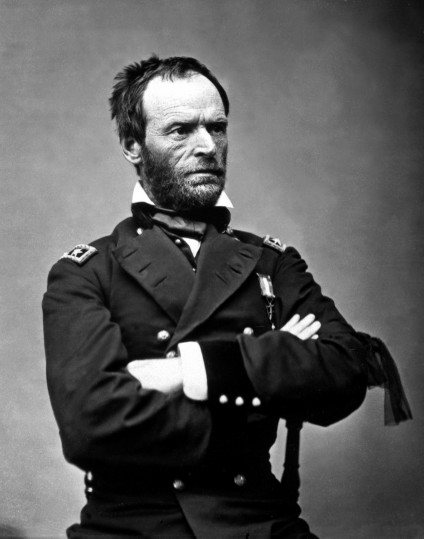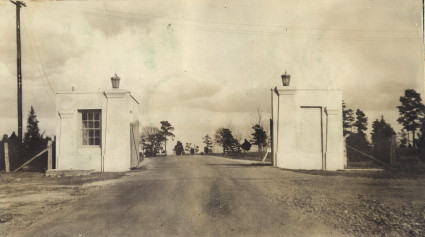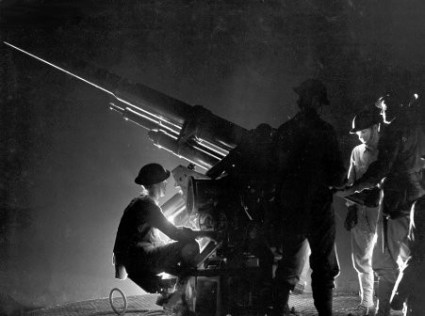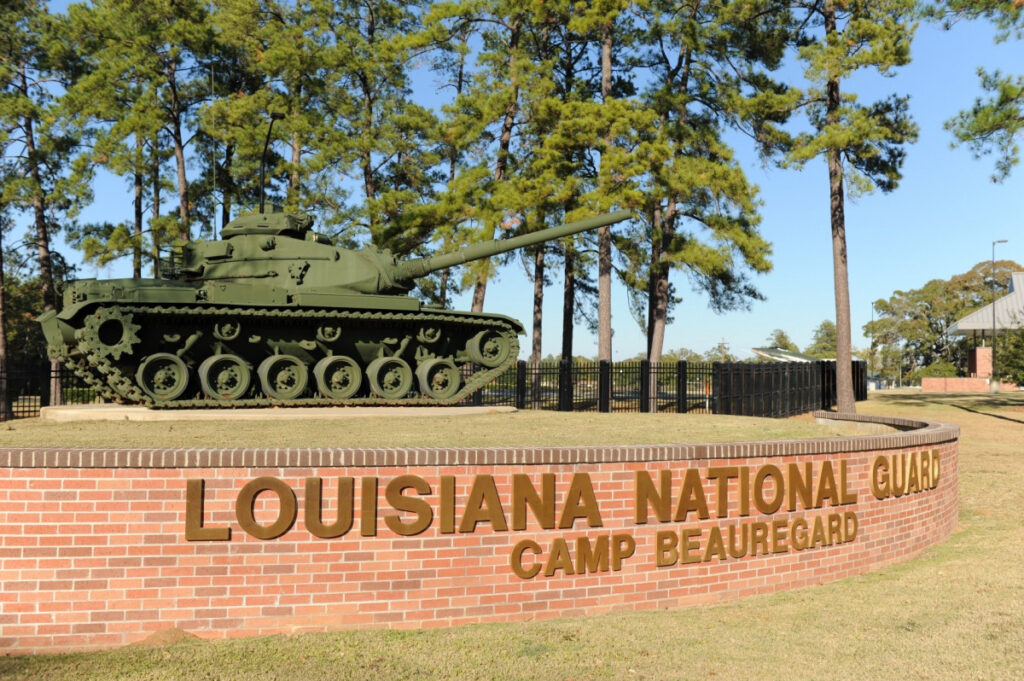EARLY HISTORY
Training Center Pineville can trace its roots to the Louisiana Seminary of Learning and Military Academy, constructed in the late 1850s in Pineville. Its first Superintendent was retired army officer William Tecumseh Sherman. Patterned after West Point, the school began classes with nineteen students and five professors. When the Civil War broke out in 1861, Sherman resigned and went on to become one of the most well known commanders of the Union army while most of the students dropped out to join the Confederate cause. Following the war, the academy was transferred to Baton Rouge and renamed Louisiana State University.
By 1905, the site was overgrown and largely forgotten. But that year’s state Legislature decided the state needed a permanent camp for the Louisiana State National Guard’s annual training exercises. The Pineville location was selected and named after the Adjutant General at that time, Major General David T. Stafford. Camp Stafford hosted the Guard’s annual training camp from 1905 -1913. Camp Stafford also saw some activity in 1916 when troops assembled there before reporting to the Mexican Border to support General John J Pershing’s campaign against Pancho Villa.

WORLD WAR I
In 1917, the U.S. entered World War I. When the U.S. War Department announced that it was developing sixteen cantonments for war training, Louisiana politicians and businessmen successfully lobbied for CP Stafford. It was renamed after the famous Louisiana Confederate General, Pierre Gustav Toutant Beauregard. Camp Beauregard expanded significantly from that point forward. During World War I, the camp proper totaled 3,427 acres, with over 14,000 adjoining acres for firing ranges. Neighboring landowners provided their property for maneuvers on condition that damages would be paid for by the government. The War Department was impressed with the locals’ eagerness to help the war effort.

One of the first units to arrive was the 39th Infantry Division, made up of Guardsmen from Louisiana, Arkansas, and Mississippi. More than 44,000 soldiers trained at Camp Beauregard during a 15 month period until the armistice was signed.
The biggest problem faced by the camp was disease. There were high rates of pneumonia, meningitis, mumps, measles, hookworm, and malaria. The deadliest disease, however, was influenza. In September and October of 1918 alone, over 7,000 cases were reported, with 410 deaths. Taking into account the number of men in camp at the time, it amounted to an infection rate above 50%. As activity slowed down with war’s end, the base hospital was the only federal facility to remain open. It eventually became a Veterans Administration Hospital while the rest of the site reverted back to state control.

THE LOUISIANA MANEUVERS AND WORLD WAR II
Camp Beauregard remained active as a Louisiana National Guard training camp after World War I. More acreage was acquired for a small arms and artillery firing range as well as to build a base airport. In addition to the Louisiana units, Mississippi and Alabama Guardsmen trained there during this period. The site also served as a refugee center during the Great Flood of 1927.
With the onset of the Great Depression, Major General Raymond Fleming, who was appointed Adjutant General in 1928, undertook major renovations using the federal programs that proliferated during that era. The Citizens Military Training Corps was an annual camp for young men aged seventeen to twenty four, which involved training in citizenship, self-reliance, and basic military skills. Other federal programs, including the Civilian Conservation Corps and the Works Progress Administration, constructed new facilities, developed new infrastructure, and worked on reforestation projects. Camp Beauregard continued to grow.
In 1939, war broke out in Europe, forcing the realization that the United States Army needed more training in mechanized warfare. Central Louisiana provided ideal terrain for such training. Camp Beauregard was designated Headquarters for the mission. In May of 1940, about 70,000 troops descended on Louisiana for the first war games of what became known as the Louisiana Maneuvers.
After France fell to Nazi Germany, however, the War Department federalized the National Guard, activated a new V corps, and called for more maneuvers as likelihood of U.S. entry into the war increased. More money was poured into the camp’s expansion and improvement, including a 1,000 bed hospital, new mess halls, a parade ground, and a more advanced airfield. Even more soldiers came to train in Louisiana as the military buildup continued. Army Chief of Staff, General George C. Marshall, was so pleased with central Louisiana’s role that three new camps were constructed. Camp Livingston, Camp Claiborne, and Camp Polk became involved in the maneuvers, making the region the largest training area in the nation.
The 3rd Army was training there by the summer of 1941 and when the Japanese bombed Pearl Harbor in December of that year, the military buildup only increased. Half a million American soldiers took part in the Louisiana Maneuvers and Alexandria’s population exploded. The War Department was once again impressed with the locals’ willingness to cooperate. Officers who later became household names participated in the training, including Dwight Eisenhower, Omar Bradley, Matthew Ridgeway, and George S. Patton.
Camp Beauregard remained active as a training facility and continued expansion throughout the war, eventually merging with Camp Livingston. The camps contained over 50,000 acres and trained hundreds of thousands of men.
The airfield on base was named after Lieutenant Wilmer Esler, who died in a crash there in 1941.
After war’s end, activity dissipated and Camp Beauregard was deactivated. The federal government’s lease terminated and it reverted to state control. In the following two decades, Camp Beauregard saw only sporadic activity as an assembly point for Guardsmen en route to other training sites and during one two week encampment.

TRAINING CENTER PINEVILLE TODAY

Camp Beauregard was reactivated as a major National Guard training facility in the early 1970s. A major renovation and construction effort created new armories, firing ranges, residences, training facilities, administrative buildings, and temporary living quarters, including the Stafford House for VIP guests. The post has continued to expand exponentially since.
In 2023, Camp Beauregard was renamed Training Center Pineville and is the largest National Guard post in Louisiana. It is headquarters to several Guard units, and many other units report there for annual training and other exercises. After Hurricane Katrina severely damaged Jackson Barracks, Beauregard took on many of the Headquarters and administrative functions of the New Orleans’ facility.
Training Center Pineville facilities include 12,500 acres with multiple firing ranges, vehicle training simulators, an urban assault course, counter improvised explosive lanes, several barracks buildings, combined support maintenance shops, dining facilities and storage, supply, and administrative buildings.
Esler Field’s facilities include two runways, hangers, maintenance facilities, and a helicopter flight simulator. The runways can handle the weight of most airline traffic, including Boeing 757s and C-17 Globemasters. It serves the general aviation community as well as the military, but does not schedule commercial airlines.
Louisiana Guard units train at Training Center Pineville and Esler Field for overseas combat operations, major domestic emergencies, and local first response situations. Training for activities other than combat, such as military funeral procedure, occurs on post as well. The Joint Operations Command (JOC) also operates from Beauregard. It acts as a central emergency operations center during crisis situations such as floods, hurricanes, and other disasters.
The 225th Engineer Brigade is headquartered at Training Center Pineville. It plays a critical role in emergency planning, preparation, and response based on Louisiana’s vulnerability to flooding and other natural disasters. Annual hurricane threats and spring river floods keep these military engineers very busy as they support state and local efforts to keep Louisianians safe and dry. Units of the 225th have also deployed overseas in support of our nations’ efforts to combat terrorism.
The Youth Challenge Program (YCP) is a program hosted by the Louisiana National Guard with a campus on Beauregard. Reminiscent of the Citizen’s Military Training Corps in the 1930s, it is a rigorous program designed to help troubled youth learn lessons in personal responsibility, self confidence, and leadership. The majority of YCP graduates achieve a high school diploma or equivalency. The program helps many young people find a place in the workforce or in higher education.
Beauregard has also been a home to Officer Candidate School(OCS) in Louisiana for more than 50 years. Candidates are attached to the 199th Leadership Regiment during their enrollment and return their parent units as a 2nd Lieutenant upon completion. A Non-Commissioned Officer Academy at nearby Camp Cook is part of the 199th.
The camp also hosts many competitions and events, including the Best Warrior Competition and the Marksmanship Tournament Competition. Family oriented events include Kids’ AT and the children’s science and math education camp, Starbase. The Louisiana Maneuvers and Military Museum displays many artifacts, emphasizing Training Center Pineville and Central Louisiana’s role in World War II.
Training Center Pineville and Esler Field are at the center of the Louisiana National Guard’s readiness efforts to serve the nation, the state, and local communities in their time of need. Both facilities continue to grow and and will continue their mission of service.
